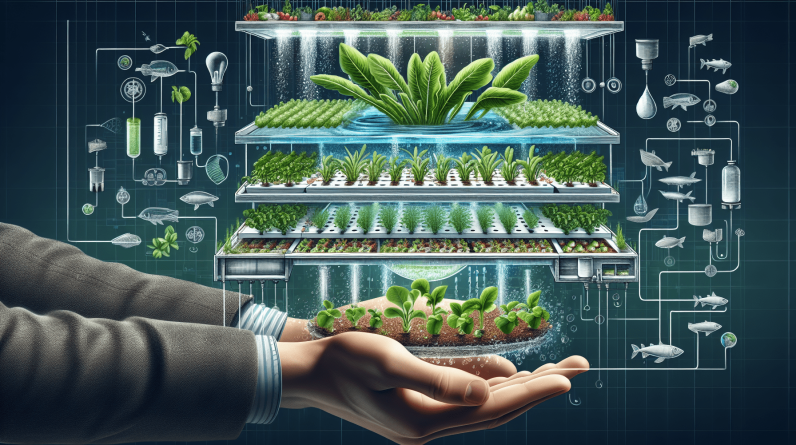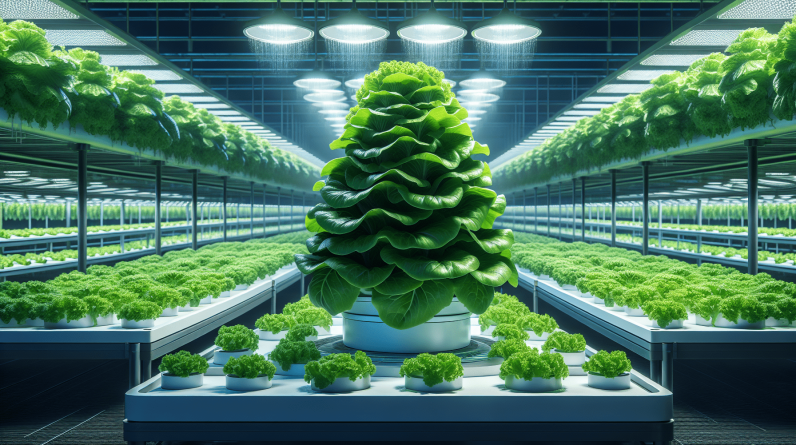
Are you ready to take your hydroponic setup to the next level? If so, selecting the right lighting system is crucial for the success of your indoor garden. With a wide range of options available, finding the best lighting system can be overwhelming. But fear not, as this article will guide you through the selection process, helping you make an informed decision that will optimize your plants’ growth and yield. From understanding the different types of lighting systems to considering the light intensity and spectrum, we will cover all the essential factors to ensure you select the best lighting system for your hydroponic setup. So let’s get started on creating the ideal environment for your plants to thrive and flourish.
Understanding Hydroponic Lighting Systems
When it comes to hydroponic gardening, lighting plays a crucial role in the success and growth of your plants. Since hydroponic systems don’t rely on natural sunlight, selecting the right lighting system becomes even more important. In this article, we will dive into the importance of lighting in hydroponic systems and explore the different types of hydroponic lighting systems available in the market. So, let’s shed some light on this topic and help you make an informed decision for your setup.
Importance of Lighting in Hydroponic Systems
Lighting is a vital factor in hydroponic gardening as it serves as an artificial substitute for natural sunlight. Plants require light for photosynthesis, which is the process by which they convert light energy into chemical energy, fueling their growth. In a hydroponic system, where plants are grown without soil, providing the right amount and quality of light is crucial to ensure optimal growth, flowering, and fruiting. Without adequate lighting, plants may become weak and leggy, and their overall health and productivity may suffer.
Different Types of Hydroponic Lighting Systems
Before we dive into the factors to consider before selecting a lighting system, let’s familiarize ourselves with the different types of hydroponic lighting systems available in the market. The three most common types are fluorescent grow lights, high-intensity discharge (HID) grow lights, and LED grow lights.
Factors to Consider Before Selecting a Lighting System
When it comes to selecting a lighting system for your hydroponic setup, there are several factors you need to take into consideration. Understanding these factors will help you make an informed decision and choose a lighting solution that perfectly meets your plants’ requirements, growing space, energy efficiency goals, and budget.
Plants’ Light Requirements
Different plants have different light requirements. Some plants thrive under intense lighting conditions, while others prefer more subtle lighting. It is crucial to understand the specific light requirements of the plants you intend to grow in your hydroponic system. Consider factors like the optimal light intensity, duration, and light color spectrum preferred by your plants to ensure their healthy growth and development.
Growing Space
The size and layout of your growing space will also play a significant role in determining the type of lighting system that is best suited for your hydroponic setup. Consider factors like the available space, height restrictions, and the number of plants you plan to grow. For smaller spaces, compact lighting systems with efficient coverage may be more suitable, while larger spaces may require more powerful lighting solutions or multiple light fixtures.
Energy Efficiency
In today’s world, energy efficiency is a crucial consideration for any type of lighting system. Opting for energy-efficient lighting not only helps you save on electricity bills but also reduces the overall environmental impact. Look for lighting systems that offer high energy efficiency ratings, such as LED grow lights, which are known for their low energy consumption and long lifespan.
Budget
Budget is an important factor to consider when selecting a lighting system for your hydroponic setup. While it may be tempting to opt for the cheapest option available, it is essential to strike a balance between quality and cost. Consider the long-term savings and benefits provided by different lighting systems. Investing in a high-quality lighting system may initially seem expensive but can pay off in terms of improved plant growth and reduced maintenance and replacement costs in the long run.

Types of Hydroponic Lighting Systems
Now that we have discussed the factors to consider, let’s explore the different types of hydroponic lighting systems in more detail. Understanding the advantages, disadvantages, suitability, and recommended products for each type will help you make an informed decision.
Fluorescent Grow Lights
Fluorescent grow lights have been widely used in hydroponic gardening for their affordability and versatility. They come in two main types: compact fluorescent lights (CFLs) and high-output fluorescent lights (HOFLs). CFLs are suitable for smaller spaces and provide a range of color temperatures, while HOFLs are more powerful and better suited for larger spaces.
Advantages
- Affordable and readily available in the market.
- Energy-efficient compared to older fluorescent technologies.
- Provide a broad spectrum of light suitable for various stages of plant growth.
- Produce less heat, reducing the risk of overheating plants.
Disadvantages
- May not provide sufficient intensity for plants with higher light requirements.
- Bulbs need to be replaced more frequently compared to other lighting systems.
- May not be as long-lasting as other lighting options.
- Not the most efficient lighting system in terms of energy consumption.
Suitable for
- Seedlings, herbs, and leafy greens.
- Smaller hydroponic setups or areas with limited space.
- Growers on a tight budget looking for an affordable lighting option.
Recommended products
- T5 HO Fluorescent Grow Light Fixtures
- CFL 4-Bulb Grow Light Fixture
High-Intensity Discharge (HID) Grow Lights
HID grow lights are known for their high light intensity and are popular among professional growers. These lights emit strong light that closely resembles natural sunlight and are available in two main types: metal halide (MH) and high-pressure sodium (HPS).
Advantages
- High light intensity, making them suitable for plants with high light requirements.
- Efficient for promoting vegetative growth and flowering stages.
- Long-lasting and durable compared to fluorescent lights.
- Proven track record of successful use in hydroponic gardening.
Disadvantages
- Produce a significant amount of heat, requiring proper ventilation and cooling measures.
- Energy consumption is relatively high compared to other lighting options.
- Initial setup costs may be higher compared to fluorescent lights.
- Require separate ballasts for operation.
Suitable for
- Supplemental lighting in larger hydroponic systems.
- Plants that require high light intensity, such as fruiting plants.
- Experienced growers who can manage the heat and energy consumption.
Recommended products
- 1000W Metal Halide (MH) HID Grow Light Bulb
- 600W High-Pressure Sodium (HPS) HID Grow Light Kit
LED Grow Lights
LED grow lights have gained immense popularity in recent years due to their energy efficiency, longevity, and versatility. They use light-emitting diodes (LEDs) to produce a focused and targeted spectrum of light that can be customized to match different stages of plant growth.
Advantages
- Highly energy efficient, consuming less electricity compared to other lighting options.
- Emit low heat, reducing the risk of damage to plants and minimizing ventilation needs.
- Long lifespan, reducing the frequency of bulb replacements.
- Customizable light spectrum for different plant growth stages.
Disadvantages
- Upfront costs may be higher compared to other lighting systems.
- Quality and performance vary among different LED brands, requiring thorough research before purchase.
- May require additional cooling measures for larger setups or when using higher-wattage LED panels.
- More complex technology compared to fluorescent or HID lights.
Suitable for
- Indoor gardening enthusiasts seeking energy-efficient and low-heat lighting options.
- A wide range of plants, including vegetables, herbs, and flowering plants.
- Growers looking for long-term cost savings and less frequent bulb replacements.
Recommended products
- LED Grow Light Panel with Full Spectrum
- High-Efficiency LED Grow Light Bar
Determining the Right Light Intensity and Color
Determining the right light intensity and color spectrum is crucial for the healthy growth and development of your plants. Two commonly used measurements for light intensity are lumens and lux. Lumens measure the total amount of visible light emitted by a source, while lux measures the intensity of light falling on a surface.
When it comes to the light color spectrum, different plant stages require different wavelengths of light for optimal growth. In general, blue light promotes vegetative growth, while red light stimulates flowering and fruiting. Some LED grow lights offer customizable color spectrums, allowing you to tailor the light output based on the specific needs of your plants at each stage.

Lighting Control and Automation
To ensure optimal growth and productivity, it is essential to have control over your hydroponic lighting system. Many lighting systems offer control and automation features that can simplify the lighting setup and management process.
Timer Options
Timers allow you to automate the lighting schedule and ensure consistent light exposure for your plants. By setting specific on and off times, you can recreate natural day-night cycles and provide your plants with the required duration of light exposure.
Dimming Features
Some lighting systems offer dimming capabilities, allowing you to adjust the light intensity based on your plants’ needs. This feature can be particularly useful during different growth stages, as it enables you to provide varying light intensities to promote healthier growth and flowering.
Remote Control and Smart Home Integration
Certain advanced lighting systems offer remote control options, allowing you to manage and customize your lighting setup from a distance. Additionally, some lighting systems can be integrated with smart home systems, enabling you to control them using mobile applications or voice commands, adding convenience and flexibility to your hydroponic gardening experience.
Installation and Positioning of Lights
Proper installation and positioning of lights are essential for even light distribution and effective plant coverage. Consider the following factors to ensure optimal lighting conditions for your hydroponic setup.
Mounting Options
Different lighting systems offer various mounting options, including hanging, ceiling-mounted, or wall-mounted setups. Choose a mounting option that is suitable for your growing space and ensures proper coverage for your plants.
Optimal Distance Between Lights and Plants
Maintaining the right distance between your lights and plants is crucial to avoid issues like burning or stretching of plant growth. Each lighting system has specific recommendations regarding the ideal distance, so make sure to follow the manufacturer’s guidelines for optimal plant growth.
Avoiding Shadowing and Hot Spots
To ensure even light distribution throughout your hydroponic garden, it is essential to position the lights in a way that avoids shadowing and hot spots. By strategically placing the lights and considering factors like reflectors and light angles, you can achieve uniform coverage and prevent any areas from being underlit or overheated.

Maintenance and Lifespan of Hydroponic Lighting Systems
Regular maintenance and proper care of your hydroponic lighting system are necessary to ensure its longevity and optimal performance. Consider the following aspects for maximum efficiency and lifespan of your lighting system.
Cleaning Procedures
Dust and debris can accumulate on the light fixtures over time, reducing their efficiency. Regularly clean the fixtures using a soft cloth or a mild cleaning solution to remove any dirt or residue. Ensure that the lights are turned off and disconnected from the power source before cleaning.
Replacing Bulbs or Components
Different lighting systems have different lifespans for their bulbs or components. It is essential to keep track of the recommended replacement intervals and schedule replacements accordingly to maintain optimal light output and plant growth.
Expected Lifespan of Different Lighting Systems
The lifespan of a lighting system can vary based on the type and quality of the lights. LED grow lights are known for their long lifespans, often exceeding 50,000 hours of continuous use. Fluorescent lights generally have a lifespan of around 10,000 to 20,000 hours, while HID lights can last between 10,000 to 24,000 hours depending on the specific type and usage.
Understanding these maintenance practices and the expected lifespan of your lighting system will help you plan for replacements and ensure continuous and efficient plant growth in your hydroponic setup.
In conclusion, selecting the right hydroponic lighting system is essential for the success of your indoor garden. Consider the light requirements of your plants, the available growing space, energy efficiency, and your budget before making a decision. Fluorescent grow lights, HID grow lights, and LED grow lights are popular options, each with its own advantages and disadvantages. Remember to determine the right light intensity and color spectrum for your plants, consider control and automation features, and pay attention to proper installation, positioning, and maintenance of your lighting system. With careful consideration and research, you can create the optimal lighting environment for your hydroponic garden and enjoy healthy and thriving plants all year round.
Related Content
- The Ultimate Guide to Hydroponic Growing for Beginners: 7 Effective Tips for 2025
- Maximizing Space and Yield with Vertical Hydroponics
- 10 Effective DIY Hydroponic System Tips for 2025: The Ultimate Guide
- 10 Effective best hydroponic vegetables to Grow in 2025: Ultimate Guide
- How to Grow Basil Hydroponically: 7 Effective Tips for 2025







